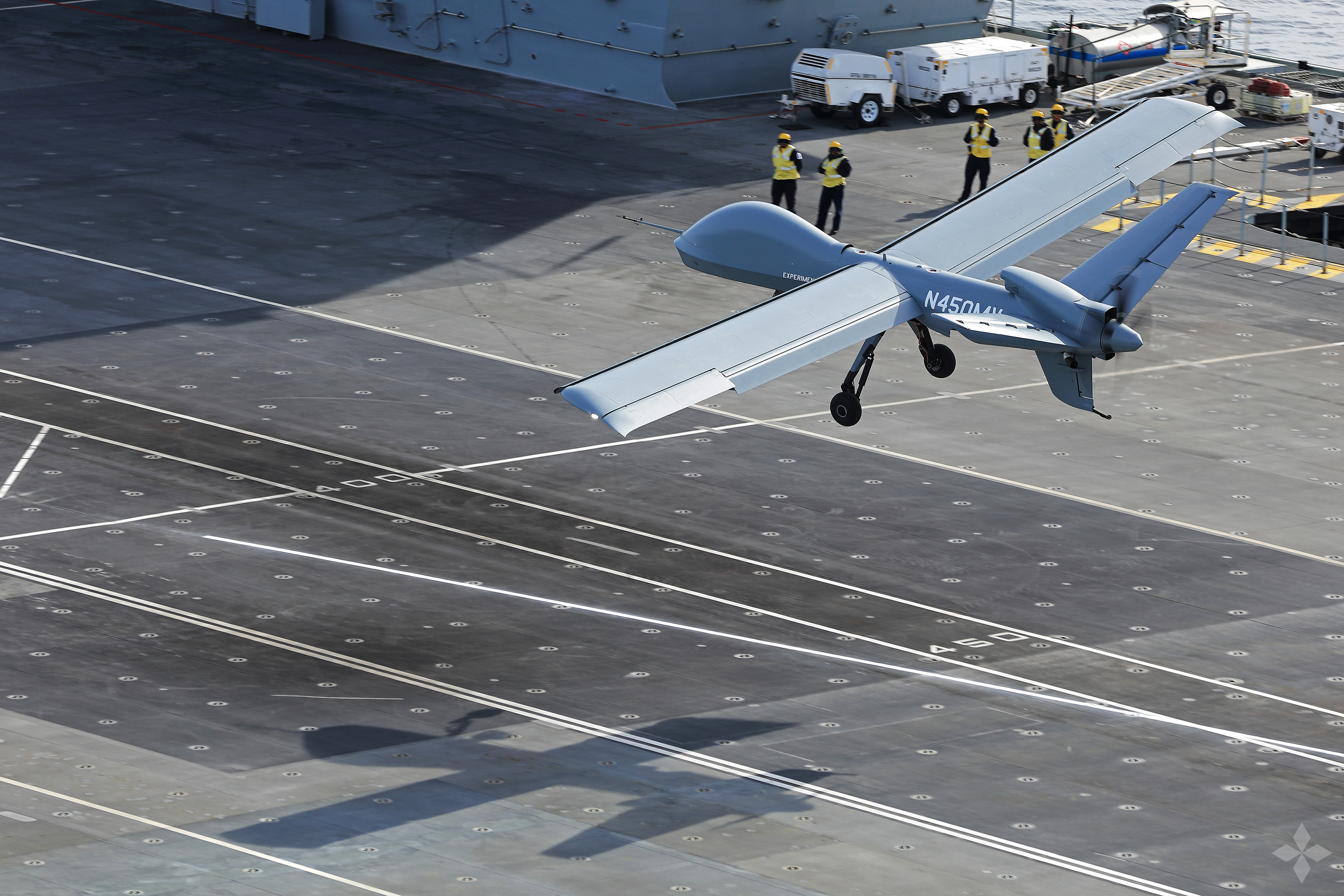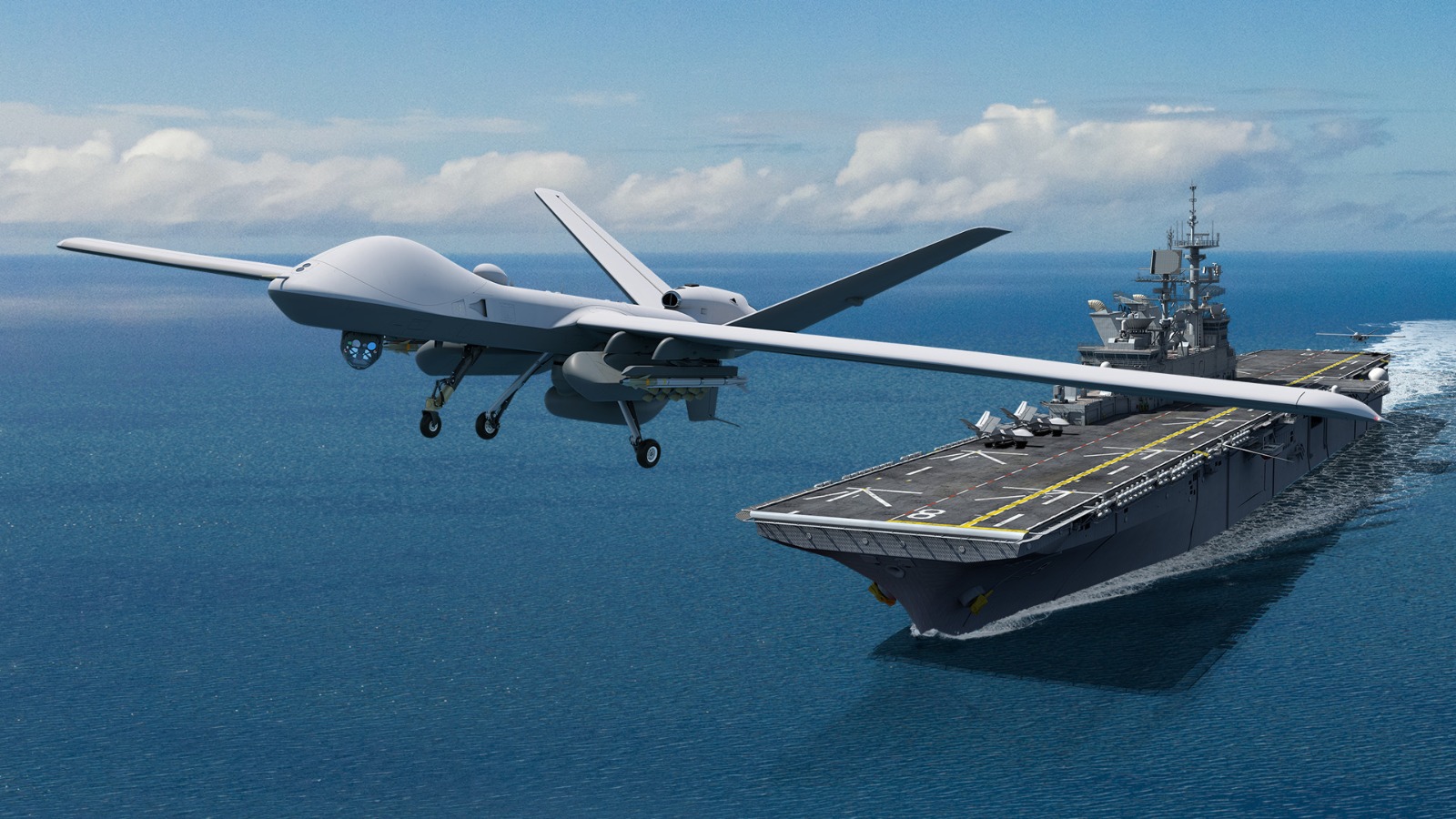US-based drone manufacturer General Atomics has released footage showcasing the testing of its Mojave drone on the HMS Prince of Wales, the UK Royal Navy’s aircraft carrier.
The published video featuring the testing of the Mojave drone on the HMS Prince of Wales offers a detailed glimpse into the drone’s performance, particularly during short takeoffs and landings on the aircraft carrier’s deck.
The testing was carried out on November 15 off the United States East Coast, as reported by the EurAsian Times at the time. The event represented the deployment of a British aircraft carrier’s largest unmanned aircraft ever launched.
The newly released video at the start depicts the Mojave drone moving from the hangar of the Prince of Wales to the flight deck through an elevator. It then positions itself at the rear of the vessel’s flight deck before takeoff.
The drone smoothly takes off from the flight deck, illustrating its ability to become airborne without utilizing the ship’s ski jump ramp. However, the footage doesn’t show the entire takeoff process.
GA-ASI and @RoyalNavy made aviation history by launching and recovering #MojaveUAS aboard @HMSPWLS.
Mojave is the first UAS in its class to take off and land on the flight deck of a naval warship, redefining what’s possible for UAS operating at sea.
➡️https://t.co/GPW0s0V841 pic.twitter.com/dgs0RsLq41
— GA-ASI (@GenAtomics_ASI) December 11, 2023
Following a circling maneuver around the carrier, the drone initiates a deliberate and controlled approach for landing, seemingly coming to a complete stop on the flight deck, leaving ample unused deck length.
General Atomics said, “Engineers and executives at General Atomics Aeronautical Systems, Inc., were confident the short takeoff and landing demonstrator Mojave could, and would, launch from an aircraft carrier and then land back aboard the first time.”
A General Atomics engineer likened the event to taking a sport utility vehicle on a backcountry trail for the first time and highlighted confidence in the Mojave’s design and capabilities, as stated in a press release accompanying the video release.
“You know it was built for that. You know it’s got a mode for that, the right tires, high clearance, everything. You need to go out and prove it,” said an engineer involved with the project.

In preparation for experimental operations with the Royal Navy, General Atomics engineers aimed to simulate controlling the Mojave drone at sea, departing from the usual ground control stations.
They created a mobile ground control station on a truck bed, which enabled practice at sea-like speeds. Over 100 takeoffs and landings were conducted using this setup. Lessons learned during pre-carrier testing included the need for seat belts, which were quickly addressed with harnesses.
Mojave Unmanned Aircraft System
General Atomics introduced the Mojave in 2021, a runway-independent, medium-altitude, long-endurance aircraft derived from the successful Gray Eagle. A short takeoff and vertical landing (STOVL) design prioritizes reduced ground roll for takeoff and landing, functioning effectively on rough surfaces.
According to the manufacturer, “It is the next step in UAS evolution, delivering unprecedented expeditionary short-takeoff and landing (STOL) performance, C-130 airlift transportability, and a significant increase in firepower — without compromising any of the significant advantages in endurance, persistence, or aircrew safety over manned aircraft. Simply put, no aircrew is on board in any danger from the enemy.”
Notably, Mojave distinguishes itself with its expansive wings and high-lift devices, standing out from its counterparts like the MQ-9 Reaper and MQ-1C Gray Eagle-ER.
General Atomics emphasizes that the Mojave has substantial flight endurance, although this depends on increased fuel and added payload, contributing to its weight.
The drone, featuring a 52-foot wingspan, is tailored for carrier-based operations. This eliminates the need for a catapult or arresting gear during recovery.
Its versatility is evident in accommodating various sensors, including radars with synthetic aperture imaging, signals intelligence suites, communications packages, and a sensor turret under its nose.

Mojave outperforms conventional models with its exceptional ability to perform successful landings, re-armaments, and takeoffs in demanding locations, particularly in non-permissive environments.
The Short Takeoff and Vertical Landing (STOVL) capability broadens the range of deployment possibilities, potentially enabling aircraft carrier-based operations. This capability unlocks opportunities for naval missions and provides sea-based support for special operations forces.
Its enlarged wing area enables it to carry up to 16 AGM-114 Hellfire or similar missiles, weighing 3,600 lb. (1,633 kg).
Additionally, Mojave can be equipped with diverse sensors like EO/IR, SIGINT, and Synthetic Aperture Radar/Ground Moving Target Indicator (SAR/GMTI), enhancing its effectiveness in land or marine missions.
- Contact the author at ashishmichel(at)gmail.com
- Follow EurAsian Times on Google News




